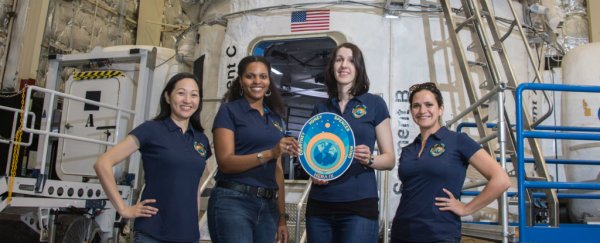The US space agency has just announced that it'll be sticking four volunteers inside a tiny house for 30 days, as part of an experiment to test how isolation and "close quarters" affect people's behaviour. Once inside, the volunteers can't leave the cabin, and will only be able to regularly communicate with each other and NASA mission control (that means no Internet).
It sounds pretty uncomfortable, but if we want to make it further into space - all the way to Mars, for example - people are going to have to live in cramped spaces for months at a time with very little contact with the outside world, and scientists need to be able to predict the effects - including every little thing that could go wrong.
The compact, three-storey house that the volunteers will be living in is called the Human Research Exploration Analog (HERA), and it's what NASA is calling a "science-making house". That means there are lots of little experiments on board to keep the team occupied, like plants to grow and tiny shrimp to take care of.
So what are they going to do in there for a whole month? Their day-to-day timeline is similar to the one followed on board the ISS, and involves 16 hours of work a day. This is divided in between planning, meetings, exercise, meals, and tending to the plants and shrimp on board.
The experiment will be simulating parts of a 715-day journey to a near-Earth asteroid, so each day will vary depending on where the crew is at in their 'mission' - outbound from Earth, at the asteroid, or in return transit.
For example, when they reach their destination, they'll need to complete virtual spacewalk missions, so that they can inspect the asteroid and collect samples. Which sounds like a whole lot of fun.
Because the environment inside HERA attempts to fully mimic what it would be like on a real expedition, there'll also be a 1 to 10 minute lag in communications with mission control, depending on the crew's theoretical position in space.
Of course, NASA's not going to make it too easy for them. "While we do all we can to avoid crises during missions, crews need to be able to respond in the event of an emergency," explains NASA over on Tumblr. "The HERA crew will conduct a couple of emergency scenario simulations, including one that will require them to manoeuvre through a debris field during the Earth-bound phase of the mission."
Throughout all of this, the crew will be wearing numerous tracking devices throughout the day, and the space agency will be collecting information about their mood, performance, team cohesion and overall wellbeing.
This isn't NASA's only experiment on the antisocial effects of space travel - over on the slopes of a Hawaiian volcano, another six NASA volunteers are taking one for the team, and spending a whole year living in isolation
While they're not actually be going into space, the Hawaiian and the HERA crew are still a whole lot braver than we are to be risking a month of sanity for the future progress of society. But it's experiments like this that make it possible for us to be able to properly assess all the potential risks, and help keep people safe, healthy, and happy in space.
We thank you for your dedication, volunteers, and can't wait to see the results. (We're also really hoping that someone is going to do a Mark Watney and create a hilarious video blog to document the whole thing. Please?)
 The Martian/20th Century Fox
The Martian/20th Century Fox


